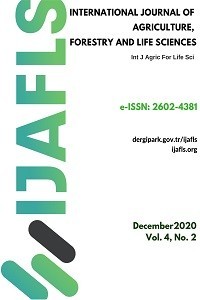EFFECTS OF PERIODS AND ALTITUDES ON THE PHENOLIC COMPOUNDS AND OIL CONTENTS OF OLIVES, cv. AYVALIK
EFFECTS OF PERIODS AND ALTITUDES ON THE PHENOLIC COMPOUNDS AND OIL CONTENTS OF OLIVES, cv. AYVALIK
fruit moisture, pulp contents, Oleuropein, Oleic acid, oil contents,
___
- Allalout, A., Krichene, D., Methenni, K., Taamall, A., Queslati, I., Daoud, D. (2009). Characterization of virgin olive oil from super intensive Spanish and Greek varieties grown in northern Tunisia. Scientia Horticulturae, 120(1):77-83.
- Anonim (2001). TS 1632 EN ISO 665 Oil seeds- Determination of moisture and volatile matter content. Türk Standardlari Enstitüsü, Necatibey Caddesi No.112 Bakanliklar/Ankara.
- AOCS (1993). Official methods and recommended practices. The American Oil Chemists Society Champaign.
- Baccouri, B., Ben Temime, S., Taamalli, W., Daoud, D., M‟sallem, M. & Zarrouk, M. (2007). Analytical characteristics of virgin olive oils from two new varieties obtained by controlled crossing on Meski variety. J. Food Lip. 14: 19–34.
- Bayçın, D., Altınok, E., Ülkü, S. & Bayraktar, O. (2007). Adsorption of olive leaf (Olea europea L.) antioxidants on silk fibroin. Joural of Agricultural and Food Chemistry, 55:1227-1236.
- Benavente-Garcia, O., Castillo, J., Lorente, J., Ortuno, A. & Del Rio, J.A. (2000). Antioxidant activity of phenolic extracted from Olea europea L. leaves. Food Chemistry, 68:457-462.
- Boselli, E., Di Lecce, G., Strabbioli, R., Pieralisi, G. & Frega, N.G. (2009). Are virgin olive oils obtained below 27 °C better than those produced at higher temperatures? LWT – Food Science and Tecnhology, 42(3):748-757.
- Boskou, D. (1996). Olive oil chemistry and technology. History and Characteristics of the Olive Tree. AOCS Press, Champaign, Illinois:1-6.
- Caponio, F., Alloggio, V. & Gomes, T. (1999). Phenolic compounds of virgin olive oil influence of paste preparation techniques. Food Chemicsty, 64:203-209.
- Covas, M.A. (2007). Olive oil and the cardiovascular system. Pharmacological Research 55: 175-186.
- Delgado-Pertinez, M., Gomez-Cabrera, A., Garrido, A. 2000. Predicting the nutritive value of the olive leaf (Olea europaea): digestibility and chemical composition and in vitro studies. Animal Feed Science and Technology, 87(3-4):187-201.
- FAOSTAT (2018). http://www.fao.org/faostat/en/#data (Access date: 17th of May, 2018).
- Gülcü, M. & Demirci, A.Ş. (2008). Zeytin ve yaprağındaki biyoaktif bileşenler ve sağlık üzerine etkileri. I. Ulusal Zeytin Öğrenci Kongresi, 17-18 Mayıs 2008, Edremit/Balıkesir, p:194-198.
- Jolayemi, O.S., Tokatli, F. & Ozen, B. (2016). Effects of malaxation temperature and harvest time on the chemical characteristics of olive oils. Food Chemistry, 211:776-783.
- Marquard, R. (1987). Qualitatsanalytik Im Dienstre der Ölpflanzenzüchtung. Fat Sci Technology, 89:95-99. Medeiros, M.D. (2001). Olive oil and health benefits. In: Wildman R.E.C. (ed.), the Handbook of Nutraceuticals and Functional Foods, Boca Raton, FL: CRC Press, 261-267.
- Meikle, R.D. (1977) Flora of Cyprus. Vol. 1. The Bentham – Moxon Trust Royal Botanic Gardens, Kew.
- Meirinhos, J., Silvia, B.M., Valentao, P., Seabra, R.M., Pereira, J.A., Dias, A., Andrade, P.B. & Ferres, F. (2005). Analysis and quantification of flavonoidic compounds from Portuguese olive (Olea europea L.) leaf cultivars. Natural Product Research, 19(2):189-195.
- Menendez, J.A., Papadimitropoulou, A., Vellon, L., Colomer, R., Lupu, R. (2006). A genomic explanation connecting “Mediterranean diet”, olive oil and cancer: Oleic acid, the main monounsaturated fatty acid olive oil, induces formation of inhibitory “PE3 transcription factor -PEA3 DNA binding site” complexes at the Her-2/neu (erB-2) oncogenese promoter in breast, ovarian and stomach cancer cells. Eur. J. Cancer 42, 2425-2432.
- Mousa, Y.M. & Gerasopoulos, D. (1996). Effect of altitude on fruit and oil quality characteristics of Mast oides’ olives. Journal of Science, Food and Agriculture, 71:345-350.
- Orgaz, F., & Fereres, E. (1997). Riego. In D. Barranco, R. Fernaandez-Escobar, & L. Rallo (Eds.), El cultivo del olivo (pp. 251e271). Madrid: Mundi-Prensa.
- Owen, R.W., Giacosa, A., Hull, W.E., Haubner, R., Würtele, G., Spigelhalder, B. & Bartsch, H. (2000). Olive-oil consumption and health: the possible role of antioxidants. The lancet Oncology, 1(2): 107-112.
- Patumi, M., D´Andria, G., Fontanazza, G., Morelli, P., Giorgio, P. & Sorrentino, G. (1999). Yield and oil quality of intensively trained trees of three cultivars of olive (Olea europea L.) under different irrigation regimes. J. Hortic. Sci. Biotech. 74 (6): 729-737.
- Pérez-Jiménez, F., Ruano, J., Perez-Martinez, P., Lopez-Segura, F. & Lopez-Miranda, J. (2007). The influence of olive oil on human health: not a question of fat alone. Mol. Nutr. Food Res. 51, 1199-1208.
- Savournin, C., Baghdikian, B., Elias, R., Dargouth-Kesraoi, F., Boukef, K. & Balansard, G. (2001). Rapid high-performance liquid chromatography analysis for the quantitative determination of oleuropein in Olea europaea leaves. Journal of Agricultural and Food Chemistry, 49:618-621.
- Skevin, D., Rade, D., Strucelj, D., Mokrovcak, Z., Nederal, S. & Bencic, D. (2003). The influence of variety and harvest time on the bitterness and phenolic compounds of olive oil. European Journal of Lipid Science and Technology, 105:536-541.
- Temime, S.B., Campeol, E., Cioni, P.L., Daoud, D. & Zarrouk, M. (2006). Volatile compounds from Chétoui olive oil and variations induced by growing area. Food Chem. 99 (2): 315-325.
- Toker, C., Aksoy, U. & Ertaş, H. (2015). The effect of fruit ripening, altitude and harvest year on volatile compounds of virgin oli oil obtained fro the Ayvalık variety. Flavour and Fragrance Journal, 31:195-205.
- Türköz, G., Baydar, T., Sözbilen, M. & Hışıl, Y. (2008). Oleoropein ve ekstraksiyon yöntemleri. I. Ulusal Zeytin Öğrenci Kongresi, 17-18 Mayıs 2018, Edremit/Balıkesir, p:151-157.
- Yayın Aralığı: Yılda 2 Sayı
- Başlangıç: 2017
- Yayıncı: Volkan OKATAN
COMPARATIVE ADVANTAGE ANALYSIS FOR TURKISH GRAPE AND CHERRIES EXPORT MARKET
Rahmiye Figen CEYLAN, Cengiz SAYIN, Burhan OZKAN, Metin Göksel AKPINAR, Eda İLBASMIŞ
Asli KACAR, Sibel AVUNDUK, Burcu OMUZBUKEN, Eray AYKIN
ANALYSIS OF TECHNICAL STRUCTURE OF SMALL RUMINANT FARMS: ŞIRNAK PROVINCE SAMPLE
EFFECT OF CLIMATE CHANGE ON MUNGBEAN GROWTH AND PRODUCTIVITY UNDER EGYPTIAN CONDITIONS
Ezzat ABD EL LATEFF, Mostafa ABD EL-SALAM, Mostafa SELIM, Medhat TAWFIK, Mohamad EL-KRAMANY, Aziza FARRAG
SOCIODEMOGRAPHIC CHARACTERISTICS OF SMALL RUMINANT FARMERS: ŞIRNAK PROVINCE SAMPLE
Miroslav ŠLOSÁR, Alžbeta HEGEDŰSOVÁ, İvana MEZEYOVÁ, Mária TIMORACKÁ, Ondrej HEGEDŰS
Hilal YILMAZ, Mevlüt GÜL, Başak AYDIN, Selcan AKKOYUN, Mehmet Emin BİLGİLİ
